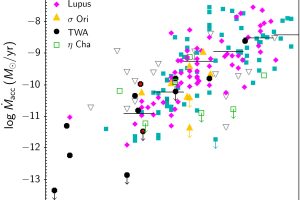Accretion and dispersion of protoplanetary disks. The study: “X-shooter spectroscopy of young stars with disks. The TW Hydrae association as a probe of the final stages of disk accretion” by L. Venuti (Eberhard Karls Universität/Cornell University/NASA) recently published by A&A

At a distance of about 160 light years, the stellar association TW Hydrae is a benchmark for the study of pre-main sequence stars and their protoplanetary disks. Pre-main sequence stars are a few million years old stars, still gravitationally contracting and not powered yet by the thermonuclear reactions. They are often surrounded by disks of dust and gas called “protoplanetary disks”, which drive the accretion of gas onto the stars and may eventually evolve in planetary systems. Disks typically disperse in less than 10 million years, while the accretion from the disk onto the star typically halts in less than 3 million years.
Stars in TW Hydrae are about 5-10 million years old, and thus their disks, being in their late evolution stage, are not expected to significantly accrete gas onto their central stars. To study the physical properties of disks in this stellar association, the astronomer Laura Venuti (from Palermo, now at the NASA Ames Research Center) has analyzed spectra of 11 stars of TW Hydrae known to host a protoplanetary disk, plus two stars whose memberhip to the association is not confirmed yet and one star without disk. The spectra were obtained with X-Shooter, mounted on the Very Large Telescope of the European Southern Observatory, as part of the guaranteed-time observations granted to INAF as member of the X-shooter consortium. X-Shooter is a perfect instrument to study pre-main sequence stars. Its spectra, in fact, cover a wide range of the electromagnetic spectrum going from the U band (300 nm) to the near infrared (2480 nm). This allows us to study both stellar properties and accretion (from analysis of the optical spectra) and the disks (whose emission dominate the near infrared).
The team led by L. Venuti has observed spectral features typical of accretion in 70% of the stars in their sample. Considering the whole population of the association, the fraction of accreting stars is thus 13%-17%. Besides, about one third of the stars show spectral features typical of low-velocity wind from the disk surface and one star those of a collimated jet, which typically characterize very young and active sources. The population of accreting stars in TW Hydrae and their typical accretion rates are larger than that observed in other clusters and associations with similar age. This suggests that in suitable environments the accretion from protoplanetary disks onto their central star can last longer than usual (e.g. 3 million years). This is very important in the framework of understanding the timescales at which disks disperse and evolve in planetary systems in the different environments of the Galaxy. The results of the study are described in the paper: “X-shooter spectroscopy of young stars with disks. The TW Hydrae association as a probe of the final stages of disk accretion“, recently appeared on Astronomy & Astrophysics. Among the coauthors, the astronomer C. Argiroffi of the University of Palermo and INAF – Astronomical Observatory of Palermo.
The figure (link) shows the relation between stellar mass (in solar masses) and accretion rate (in solar masses per year) of the stars in TW Hydrae, compared with that observed in other young stellar clusters and associations.
